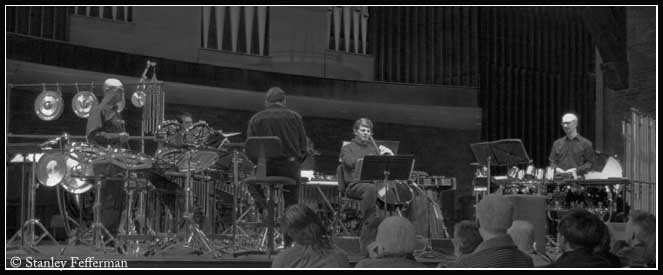 January 20, 2013. Mazzoleni Hall, Toronto.
January 20, 2013. Mazzoleni Hall, Toronto.
This was the inaugural performance of Andrès Díaz as holder of a named chair for cello at the The Glenn Gould School. We heard him play in a Cello Trio, in a Sonata for Cello and Piano, and in a work for cello and four percussions, and he impressed every time. Mr. Díaz is emphatic—he makes every stroke count.
Rachmaninoff’s Sonata in G Minor for Cello and Piano, Op. 19 is frequently spoken of as a “piano sonata with cello accompaniment,” because “the piano is undeniably the dominant instrument in the work.” Certainly, there is more piano in this sonata than in most others I’ve heard. Moreover, Jeanie Chung’s performance at the keyboard was also emphatic: she was spot on for every one of the composer’s keyboard shifts from the lyrical to the passionate mode and back. But Rachmaninoff gave most of the emotion to the cello, and Andrès Díaz gave back a performance that let you feel the full intensity of celebration and lament in the heart of this work.
The cello’s emotional dominance becomes apparent as the Andante—the strongest of the four movements—begins. The piano introduces the intimate, passionate theme that makes you want to cry. But it is only when the cello has finished expanding this material that you can feel what those tears are about: they are flowing from the pain of having to say goodbye forever. Perhaps the source of these tears is in the composer’s life-long sorrow at being exiled in 1917 from his beloved Russia. Whatever the source, it was given to Díaz’ cello to make that connection, and he did it, emphatically.
After intermission, Díaz and four of his percussionist friends*, gave us a taste of the undeniable genius of Tan Dun—his Elegy: Snow in June (1991). The image of ‘snow in June’ is a pathetic fallacy that expresses the natural world’s outcry against the injustice done to Dou Eh, a thirteenth-century Chinese woman who was executed for a crime she did not commit. The cello sings an elaborate lament for her fate and also celebrates her beauty and virtue.
The relation of cello and the percussion soloists is complex. In one instance, near the beginning, it might be said that the cello is crying and the ping of tiny handbells are tears. Drums are the drama, cracks and thumps are what we hear when things fall apart and “mere anarchy is loosed upon the world.” The rhythms of cello phrases sometimes are imitated in different timbres by percussion, and sometimes the percussions integrate the cello into their music. There are passages where the percussion accompany the cello as subject, and sometimes the group operates as a quintet where the cello is one voice in an incredibly complex but articulate conversation. Usually the language of percussion sounds like it is speaking traditional Chinese, but there is a section near the conclusion where the cello takes the tempo to presto molto agitato and the ensemble goes all African jungle.
Tan Dun’s work is at every point unity in diversity, delight in disorder. It concludes as the trilling of vibraphones, xylophones and gongs pacify the space to the sound of the cello melody’s slowing descent past the sounds of paper tearing and taking its rest in silence.
Since this was Andrès Díaz’s inaugural concert as Recipient of the Alexandra Koerner Yeo Chair in Cello, it was only fitting that the professor perform with a couple of cello students, in this case, two award winners: Daniel Hass, senior level, and Alyssa Ramsay, first year. Together, and joined by Jeanie Chung, they gave a pleasant account of a European-flavoured early 20th-century work, the lovely Requiem, Op. 66 for 3 Cellos and Piano by David Popper.
*Percussionist friends: Mark Duggan, Morris Palter, John Rudolph, Trevor Tureski, and David Kent, conductor.
